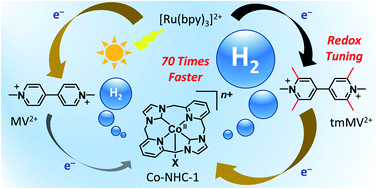The catalytic performance of a photochemical H2 evolution system made up of EDTA (ethylenediaminetetraacetic acid disodium salt), [Ru(bpy)3]2+ (bpy = 2,2′-bipyridine) and a macrocyclic N-heterocyclic carbene cobalt (Co-NHC-1) catalyst has been examined at pH 5.0 (E(2H+/H2) = −0.54 V vs. SCE) by using six electron relays (ERs) having different first reduction potentials (Ered) in the range −0.69 < Ered < −1.08 V. Compared to the photosystem using the conventional methylviologen (i.e., N,N′-dimethyl-4,4′-bipyridinium; MV2+), the overall catalytic performance is dramatically improved by employing the ERs having the reduction potentials by 0.08–0.24 V more negative than that of MV2+ (Ered = −0.69 V), revealing that the overall rate is limited by the electron transfer (ET) from the one-electron reduced ER to Co-NHC-1, correlated to hydrogen evolution reaction (HER), rather than that from [Ru*(bpy)3]2+ (triplet excited state) to ER, since the driving force for the HER (DFHER) predominates that for the ET from [Ru*(bpy)3]2+ to ER (DFET). The optimum condition was realized by selecting one of the viologen derivatives with a medium reduction potential (N,N′,2,2′,6,6′-hexamethyl-4,4′-bipyridinium; tmMV2+; Ered = −0.85 V), leading to afford the initial rate of HER (55–57 μmol h−1) 70 times higher than that obtained by using MV2+ (0.79 μmol h−1). The stability of each one-electron reduced ER under the photolysis conditions has been also examined spectrophotometrically, clarifying that some ERs rather decompose rapidly upon reduction and cannot effectively participate in HER. This study successfully demonstrates for the first time that the overall catalytic performance of the present photosystem cannot be only controlled by the tuning of DFET and DFHER but also be affected by the stability of the one-electron reduced form of ER.
